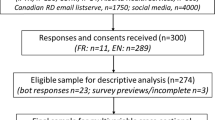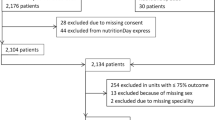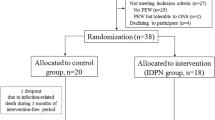Abstract
Background/Objectives
Additional strategies should be applied to optimize hospital food services, in order to increase the number of patients with adequate protein intake at mealtimes. Therefore, we aim to specify the differences in protein intake per mealtime between the traditional three meals a day food service (TMS) and a novel six times a day food service containing protein-rich food items, FoodforCare (FfC).
Subjects/Methods
This was a post-hoc analysis of a prospective cohort study comparing the TMS (July 2015 − May 2016; n = 326) to FfC (January 2016 − December 2016; n = 311) in adult hospitalized patients.
Results
Protein intake (g) was higher with FfC at all mealtimes (p < 0.05) except for dinner (median [IQR] at breakfast: 17 [6.5–25.7] vs. 10 [3.8–17]; 10:00 a.m.: 3.3 [0.3−5.3] vs. 1 [0−2.2]; lunch: 17.6 [8.4−25.8] vs. 13 [7−19.4]; 2:30 p.m.: 5.4 [0.8–7.5] vs. 0 [0–1.8]; 7:00 p.m.: 1 [0–3.5] vs. 0 [0–1.7]; 9:00 p.m.: 0 [0–0.1] vs. 0 [0–0]). At dinner, protein intake was highest for both food services (20.9 g [8.4–24.1] vs. 20.5 g [10.5–27.8]).
Conclusions
Implementation of a high-frequency food service can improve protein intake at mealtimes during the day and might be a strategy to increase the number of patients with adequate protein intake.
This is a preview of subscription content, access via your institution
Access options
Subscribe to this journal
Receive 12 print issues and online access
$259.00 per year
only $21.58 per issue
Buy this article
- Purchase on Springer Link
- Instant access to full article PDF
Prices may be subject to local taxes which are calculated during checkout


Similar content being viewed by others
References
Areta JL, Burke LM, Ross ML, Camera DM, West DW, Broad EM, et al. Timing and distribution of protein ingestion during prolonged recovery from resistance exercise alters myofibrillar protein synthesis. J Physiol. 2013;591:2319–31.
Kruizenga H. Nederlandse Prevalentiemeting Ondervoeding in Ziekenhuizen (NPOZ). Stuurgroep Ondervoeding; 2016 http://www.fightmalnutrition.eu/.
Felder S, Lechtenboehmer C, Bally M, Fehr R, Deiss M, Faessler L, et al. Association of nutritional risk and adverse medical outcomes across different medical inpatient populations. Nutrition. 2015;31:1385–93.
Agarwal E, Ferguson M, Banks M, Batterham M, Bauer J, Capra S, et al. Malnutrition and poor food intake are associated with prolonged hospital stay, frequent readmissions, and greater in-hospital mortality: results from the Nutrition Care Day Survey 2010. Clin Nutr. 2013;32:737–45.
Kruizenga H, Beijer S, Huisman-de Waal G, Jonkers-Schuitema CK, M., Remijnse-Meester W, Thijs A, et al. Guideline on malnutrition. 2017. http://www.fightmalnutrition.eu/
Deutz NE, Bauer JM, Barazzoni R, Biolo G, Boirie Y, Bosy-Westphal A, et al. Protein intake and exercise for optimal muscle function with aging: recommendations from the ESPEN Expert Group. Clin Nutr. 2014;33:929–36.
Bauer J, Biolo G, Cederholm T, Cesari M, Cruz-Jentoft AJ, Morley JE, et al. Evidence-based recommendations for optimal dietary protein intake in older people: a position paper from the PROT-AGE Study Group. J Am Med Dir Assoc. 2013;14:542–59.
Katsanos CS, Kobayashi H, Sheffield-Moore M, Aarsland A, Wolfe RR. Aging is associated with diminished accretion of muscle proteins after the ingestion of a small bolus of essential amino acids. Am J Clin Nutr. 2005;82:1065–73.
Paddon-Jones D, Rasmussen BB. Dietary protein recommendations and the prevention of sarcopenia. Curr Opin Clin Nutr Metab Care. 2009;12:86–90.
Katsanos CS, Kobayashi H, Sheffield-Moore M, Aarsland A, Wolfe RR. A high proportion of leucine is required for optimal stimulation of the rate of muscle protein synthesis by essential amino acids in the elderly. Am J Physiol Endocrinol Metab. 2006;291:381–7.
Dijxhoorn DN, van den Berg MGA, Kievit W, Korzilius J, Drenth JPH, Wanten GJA. A novel in-hospital meal service improves protein and energy intake. Clin Nutr. 2017:(in press).
Dutch Food composition table (NEVO-table 2013). In: EuroFIR AISBL e-book Collection, editor. Brussel. 2013.
Barton AD, Beigg CL, Macdonald IA, Allison SP. High food wastage and low nutritional intakes in hospital patients. Clin Nutr. 2000;19:445–9.
Beelen J, Vasse E, Janssen N, Janse A, de Roos, NM, de Groot L. Protein-enriched familiar foods and drinks improve protein intake of hospitalized older patients: A randomized controlled trial. Clin Nutr. 2018;37:1186–1192.
Barton A, Beigg C, Macdonald I, Allison S. A recipe for improving food intakes in elderly hospitalized patients. Clin Nutr [Internet]. 2000;19:451–4. pp
Tieland M, Borgonjen-Van den Berg KJ, van Loon LJ, de Groot LC. Dietary protein intake in community-dwelling, frail, and institutionalized elderly people: scope for improvement. Eur J Nutr. 2012;51:173–9.
Groen Bart BLB. Intragastric protein administration stimulates overnight muscle protein synthesis in elderly men. Am J Physiol Endocrinol Metab. 2012;302:52–60.
Schutz P, Bally M, Stanga Z, Keller U. Loss of appetite in acutely ill medical inpatients: physiological response or therapeutic target? Swiss Med Wkly. 2014;144:13957.
Edwards JS, Hartwell HJ. Hospital food service: a comparative analysis of systems and introducing the ‘Steamplicity’ concept. J Human Nutr Diet. 2006;19:421–30.
Biolo G, Ciocchi B, Stulle M, Bosutti A, Barazzoni R, Zanetti M, et al. Calorie restriction accelerates the catabolism of lean body mass during 2 wk of bed rest. Am J Clin Nutr. 2007;86:366–72.
Wall BT, van Loon LJC. Nutritional strategies to attenuate muscle disuse atrophy. Nutr Rev. 2013;71:195–208.
Funding
The study was funded by the FoodforCare Foundation.
Author information
Authors and Affiliations
Corresponding author
Ethics declarations
Conflict of interest
The authors declare that they have no conflict of interest.
Rights and permissions
About this article
Cite this article
Dijxhoorn, D.N., IJmker-Hemink, V.E., Wanten, G.J.A. et al. Strategies to increase protein intake at mealtimes through a novel high-frequency food service in hospitalized patients. Eur J Clin Nutr 73, 910–916 (2019). https://doi.org/10.1038/s41430-018-0288-6
Received:
Revised:
Accepted:
Published:
Issue Date:
DOI: https://doi.org/10.1038/s41430-018-0288-6



